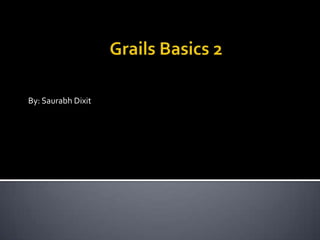
Grails basics part2
- 2. Groovy server pages Taglibs Validators in grails
- 3. View pages with the extension gsp, gsp stands for groovy server page All default groovy tags along with custom tags defined in the tag lib can be accessed in these pages.
- 4. Tags can be created inside taglib folder in grails: classWidgetsTagLib { static namespace = “appTags" ApplicationContext applicationContext /** * Extends the regular grails pagination */ def paginate = { attrs -> // DO some operation } Tags inside taglib can be accessed on the GSP pages through the name space: <appsTags:paginate/> appsTags: Name space defined in the tag lib Paginate: Method in the file
- 5. Declaring Constraints: Within a domain class constraints are defined with the constraints property that is assigned a code block: class User { String login String password String email Integer age static constraints = { … } }
- 6. You then use method calls that match the property name for which the constraint applies in combination with named parameters to specify constraints: class User { ... static constraints = { login size: 5..15, blank: false, unique: true password size: 5..15, blank: false email email: true, blank: false age min: 18 } }
- 7. In that example we've declared that the login property must be between 5 and 15 characters long, it cannot be blank and must be unique.We've also applied other constraints to the password, email and age properties. By default, all domain class properties are not nullable (i.e. they have an implicit nullable:false constraint).
- 8. A complete reference for the available constraints can be found in the Quick Reference section under the Constraints heading. class User { ... static constraints = { // this Date object is created when the constraints are evaluated, not // each time an instance of the User class is validated. birthDate max: new Date() } } Custom validator: class Response { … static constraints = { survey blank: false answer blank: false, validator: { val, obj -> val in obj.survey.answers } } }
- 9. Validating Constraints: Call the validate method to validate a domain class instance: def user = new User(params) if (user.validate()) { // do something with user } else { user.errors.allErrors.each { println it } } The errors property on domain classes is an instance of the Spring Errors interface.The Errors interface provides methods to navigate the validation errors and also retrieve the original values.
- 10. Validation Phases: Within Grails there are two phases of validation, the first one being data binding which occurs when you bind request parameters onto an instance such as: def user = new User(params)
- 11. At this point you may already have errors in the errors property due to type conversion (such as converting Strings to Dates).You can check these and obtain the original input value using the Errors API: if (user.hasErrors()) { if (user.errors.hasFieldErrors("login")) { println user.errors.getFieldError("login").rejectedValue } }
- 12. The second phase of validation happens when you call validate or save.This is when Grails will validate the bound values againts the constraints you defined. For example, by default the save method calls validate before executing, allowing you to write code like: if (user.save()) { return user } else { user.errors.allErrors.each { println it } }
- 13. Importing Constraints: Grails 2 introduced an alternative approach to sharing constraints that allows you to import a set of constraints from one class into another. Let's say you have a domain class like so: class User { String firstName String lastName String passwordHash static constraints = { firstName blank: false, nullable: false lastName blank: false, nullable: false passwordHash blank: false, nullable: false } }
- 14. You then want to create a command object, UserCommand, that shares some of the properties of the domain class and the corresponding constraints.You do this with the importFrom() method: class UserCommand { String firstName String lastName String password String confirmPassword static constraints = { importFrom User password blank: false, nullable: false confirmPassword blank: false, nullable: false } }
- 15. If you want more control over which constraints are imported, use the include and exclude arguments. Both of these accept a list of simple or regular expression strings that are matched against the property names in the source constraints.
- 16. So for example, if you only wanted to import the 'lastName' constraint you would use: … static constraints = { importFrom User, include: ["lastName"] … } or if you wanted all constraints that ended with 'Name': … static constraints = { importFrom User, include: [/.*Name/] … }
- 17. Validation on the Client: Displaying Errors: ▪ Typically if you get a validation error you redirect back to the view for rendering. Once there you need some way of displaying errors. ▪ Grails supports a rich set of tags for dealing with errors. ▪ To render the errors as a list you can use renderErrors: <g:renderErrors bean="${user}" />
- 18. If you need more control you can use hasErrors and eachError: <g:hasErrors bean="${user}"> <ul> <g:eachError var="err" bean="${user}"> <li>${err}</li> </g:eachError> </ul> </g:hasErrors>
- 19. ApplyingValidation to Other Classes: Domain classes and command objects support validation by default. Other classes may be made validateable by defining the static constraints property in the class (as described above) and then telling the framework about them. It is important that the application register the validateable classes with the framework. Simply defining the constraints property is not sufficient.
- 20. TheValidateable Annotation: Classes which define the static constraints property and are annotated with @Validateable can be made validateable by the framework. Consider this example: // src/groovy/com/mycompany/myapp/User.groovy package com.mycompany.myapp import grails.validation.Validateable @Validateable class User { ... static constraints = { login size: 5..15, blank: false, unique: true password size: 5..15, blank: false email email: true, blank: false age min: 18 } }
